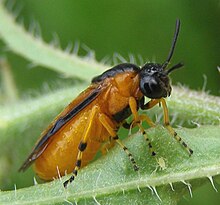Rose-brush horn wasp
| Rose-brush horn wasp | ||||||||||||
|---|---|---|---|---|---|---|---|---|---|---|---|---|

Rose-brush horn wasp ( Arge ochropus ), dorsal view |
||||||||||||
| Systematics | ||||||||||||
|
||||||||||||
| Scientific name | ||||||||||||
| Arge ochropus | ||||||||||||
| ( Gmelin in Linnaeus , 1790) |
The rosebush horn wasp ( Arge ochropus , syn .: Arge rosae ) is a plant wasp from the family of the brush horn sawfly . It is one of 18 species of the genus in Germany.
features
The plant wasps are seven to ten millimeters long. Your head is black. They have an abdomen that is larger than the width of the front limbs. The mesonotum is black, the rest of the thorax is yellow or red-yellow. This is how the species can be distinguished from all other Central European Arge species. The abdomen is bright yellow in color. In the male, the cerci are black and sharply set off against the yellow abdomen. The legs are almost entirely colored yellow. The apical ends of the tibia are black. The tarsi also have black rings. The predominantly black antennae usually show a yellow coloring on the apical two-thirds. Along the front edge of the forewings there is a black border to the wing mark, which is also black . The rose-brush horn wasp has no sting and can therefore not sting. However, the female has an ovipositor with which she lays 16 to 18 eggs in a row on the host plant.
The larvae are yellow on top and whitish on the underside. The head capsule is yellow. The body is covered with black spots. The larvae resemble those of Arge pagana . However, the larvae of Arge ochropus each have a black spot immediately behind the stigmata (tracheal openings).
distribution
The species occurs in Europe, in western and central Asia and in the Mediterranean area. In Central Europe it is widespread and not uncommon, it also occurs in home gardens. It is considered an agricultural pest in commercial rose cultivation.
Way of life
The larvae of Arge ochropus live on different types of roses . The following are named as food plants: Rosa canina , Rosa gallica , Rosa rubiginosa , Rosa majalis and Rosa pimpinellifolia as well as Rosa damascena in Asia Minor . The adults are flower visitors without any ties to roses. B. often on the flowers of umbelliferae . Arge ochropus is considered to be somewhat heat-loving. It often comes with related species such as B. Arge pagana . The adults' flight time is summer (April / May to August). The species forms two or three overlapping generations in Central Europe. The larvae live gregariously on rose bushes and can cause baldness. The pupation takes place in the ground underneath the plant. In the final stage, the larvae spin a stiff, two-layer cocoon made of silk.
The larva of Arge ochropus is like all investigated species against predators such as z. B. Ants protected by toxins. When an ant approaches, the larva curves its abdomen in its upward direction. Secretions emerging from the glands on the abdomen, but also the blood ( hemolymph ) of the larvae inhibited feeding and were toxic to ants. The rather strikingly colored larvae were also spurned by songbirds (blackbirds). Among the parasites of Pflanzenwespenart heard the wasp Tetrastichus hylotomarum .
literature
- Angela Roßmann: Lexicon of Animals. First volume, Lexicographical Institute, Munich 1977.
- Yvonne D. Burggraaf-van Nierop, Cees van Achterberg: De Cephidae en Argidae van Nederland (Hymenoptera). Zoologische Bijdragen 39, 1990, pp. 3-66.
Web links
Individual evidence
- ↑ a b Arge ochropus at Fauna Europaea. Retrieved April 28, 2019
- ↑ H. Özbek, O. Çalmaşur A review of insects and mites associated with roses in Turkey. Acta Horticulturae 690.
- ↑ Andreas Taeger, Ewald Altenhofer, Stephan M. Blank, Ewald Jansen, Manfred Kraus, Hubert Pschorn-Walcher, Carsten Ritzau: Comments on the biology, distribution and endangerment of plant wasps in Germany (Hymenoptera, Symphyta). In: Andreas Taeger, Stephan M. Blank (eds.): Plant wasps in Germany (Hymenoptera, Symphyta). Annotated inventory. Verlag Goecke & Evers, Keltern 1998, pp. 49-135.
- ↑ Ozan Demirözer, İsmail Karaca (2011): Phytophagous Arthropod Species Associated with Oil Bearing Rose, Rosa damascena Miller, in Isparta Province with Distributional Remarks. SDU Journal of Science 6 (1): 9-25.
- ↑ Hubert Pschorn-Walcher, Ewald Altenhofer: Long-term larvae collections and breeding of plant wasps (Hymenoptera, Symphyta) in Central Europe. In: Linz biological contributions. 32nd year, issue 1, Linz 2000, pp. 273-327 ( PDF on ZOBODAT ).
- ^ Charles-Albert Petre, Claire Detrain, Jean-Luc Boeve (2007): Anti-predator defense mechanisms in sawfly larvae of Arge (Hymenoptera, Argidae). Journal of Insect Physiology 53: 668-675, doi : 10.1016 / j.jinsphys.2007.04.007


